Decision-Making Preferences and Tools: A Reflective Report (MGT602)
VerifiedAdded on 2022/08/19
|19
|2122
|12
Report
AI Summary
This report analyzes the student's decision-making preferences, processes, and tools, comparing them to major personal and business decisions. It explores various decision-making models, including rational, bounded rationality, and retrospective models, along with the effects of biases and personality styles. The report provides definitions of key terms like intuition, group decisions, and rational decisions. The student reflects on their experiences, providing examples and insights into how they make decisions, including the use of rational and intuition-based approaches. Charts and figures are used to illustrate concepts like decision-making processes, effects, and feedback. The student also provides a detailed appendix summarizing key decisions, decision styles, and time frames, demonstrating a practical application of the theoretical concepts discussed. The report concludes by emphasizing the importance of the rational method and intuition in decision-making and the value of learning from past experiences.
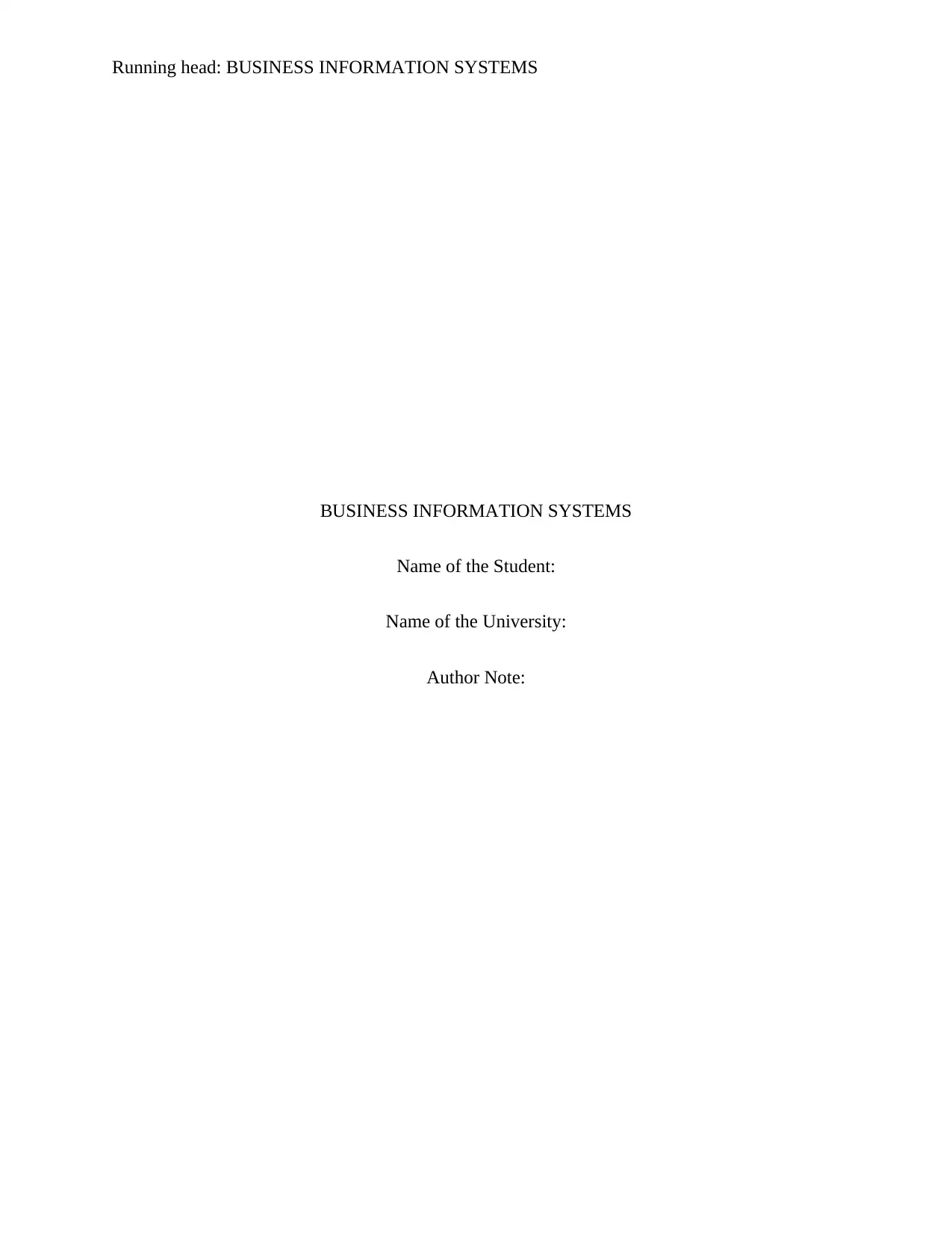
Running head: BUSINESS INFORMATION SYSTEMS
BUSINESS INFORMATION SYSTEMS
Name of the Student:
Name of the University:
Author Note:
BUSINESS INFORMATION SYSTEMS
Name of the Student:
Name of the University:
Author Note:
Paraphrase This Document
Need a fresh take? Get an instant paraphrase of this document with our AI Paraphraser
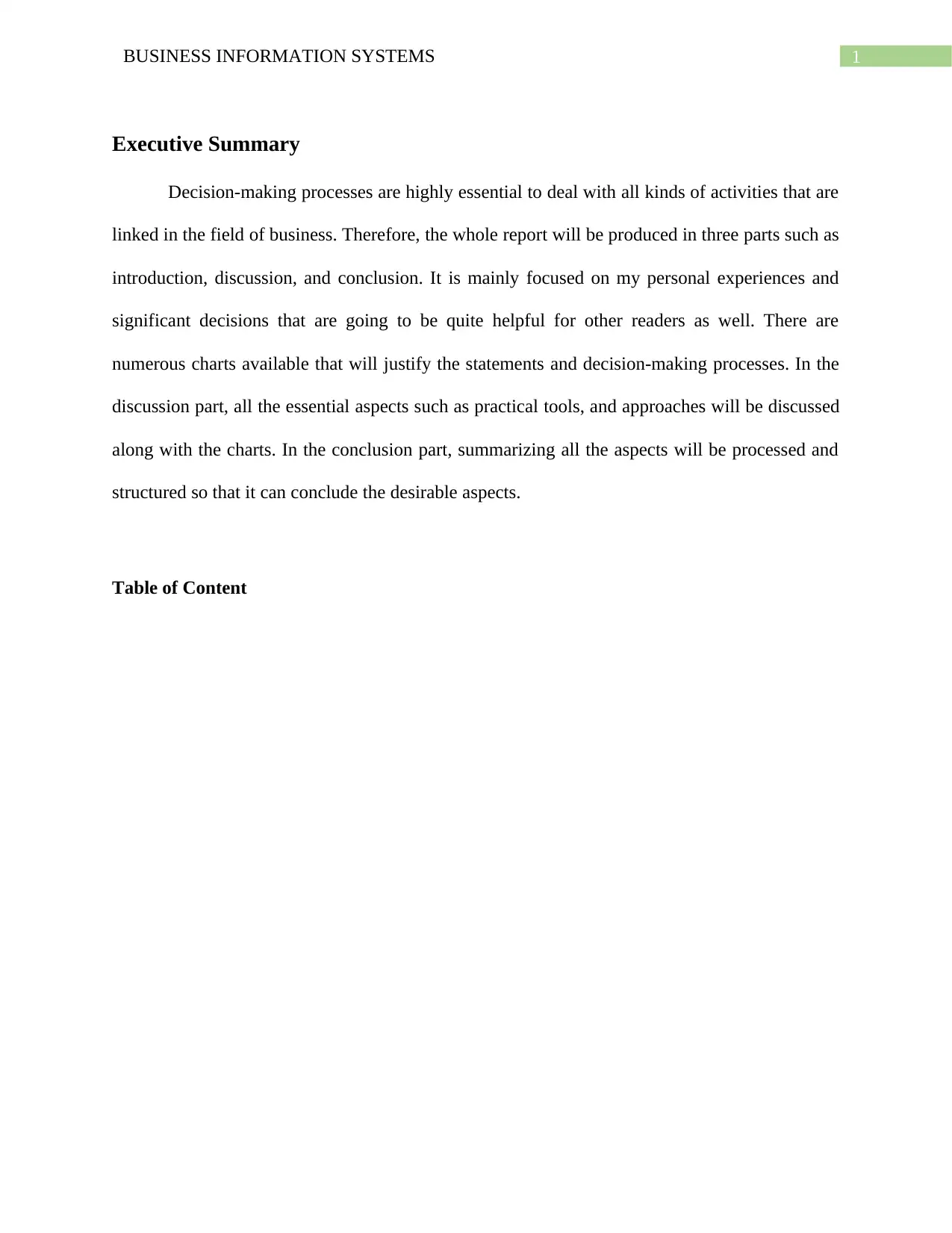
1BUSINESS INFORMATION SYSTEMS
Executive Summary
Decision-making processes are highly essential to deal with all kinds of activities that are
linked in the field of business. Therefore, the whole report will be produced in three parts such as
introduction, discussion, and conclusion. It is mainly focused on my personal experiences and
significant decisions that are going to be quite helpful for other readers as well. There are
numerous charts available that will justify the statements and decision-making processes. In the
discussion part, all the essential aspects such as practical tools, and approaches will be discussed
along with the charts. In the conclusion part, summarizing all the aspects will be processed and
structured so that it can conclude the desirable aspects.
Table of Content
Executive Summary
Decision-making processes are highly essential to deal with all kinds of activities that are
linked in the field of business. Therefore, the whole report will be produced in three parts such as
introduction, discussion, and conclusion. It is mainly focused on my personal experiences and
significant decisions that are going to be quite helpful for other readers as well. There are
numerous charts available that will justify the statements and decision-making processes. In the
discussion part, all the essential aspects such as practical tools, and approaches will be discussed
along with the charts. In the conclusion part, summarizing all the aspects will be processed and
structured so that it can conclude the desirable aspects.
Table of Content
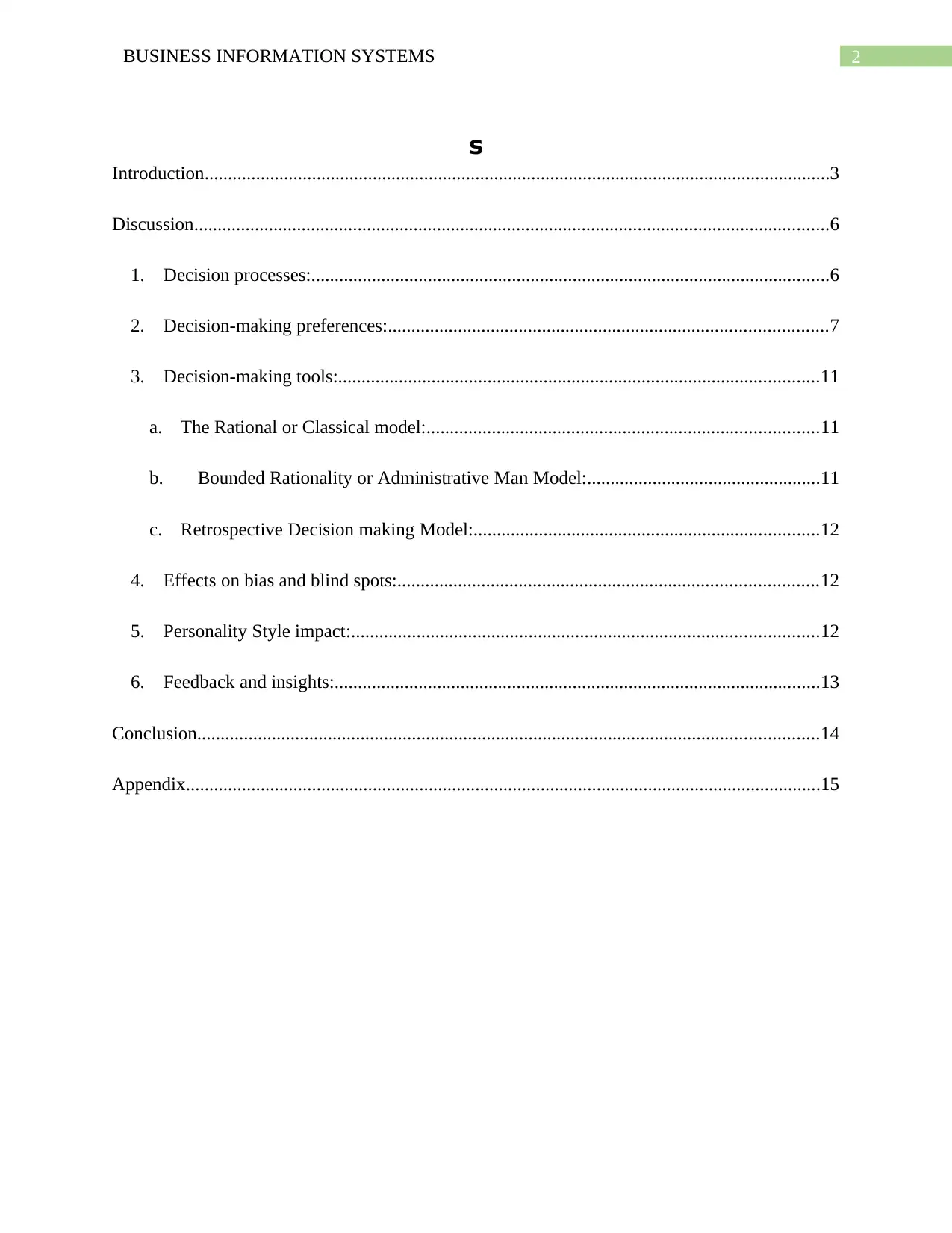
2BUSINESS INFORMATION SYSTEMS
s
Introduction......................................................................................................................................3
Discussion........................................................................................................................................6
1. Decision processes:...............................................................................................................6
2. Decision-making preferences:..............................................................................................7
3. Decision-making tools:.......................................................................................................11
a. The Rational or Classical model:....................................................................................11
b. Bounded Rationality or Administrative Man Model:..................................................11
c. Retrospective Decision making Model:..........................................................................12
4. Effects on bias and blind spots:..........................................................................................12
5. Personality Style impact:....................................................................................................12
6. Feedback and insights:........................................................................................................13
Conclusion.....................................................................................................................................14
Appendix........................................................................................................................................15
s
Introduction......................................................................................................................................3
Discussion........................................................................................................................................6
1. Decision processes:...............................................................................................................6
2. Decision-making preferences:..............................................................................................7
3. Decision-making tools:.......................................................................................................11
a. The Rational or Classical model:....................................................................................11
b. Bounded Rationality or Administrative Man Model:..................................................11
c. Retrospective Decision making Model:..........................................................................12
4. Effects on bias and blind spots:..........................................................................................12
5. Personality Style impact:....................................................................................................12
6. Feedback and insights:........................................................................................................13
Conclusion.....................................................................................................................................14
Appendix........................................................................................................................................15
⊘ This is a preview!⊘
Do you want full access?
Subscribe today to unlock all pages.

Trusted by 1+ million students worldwide
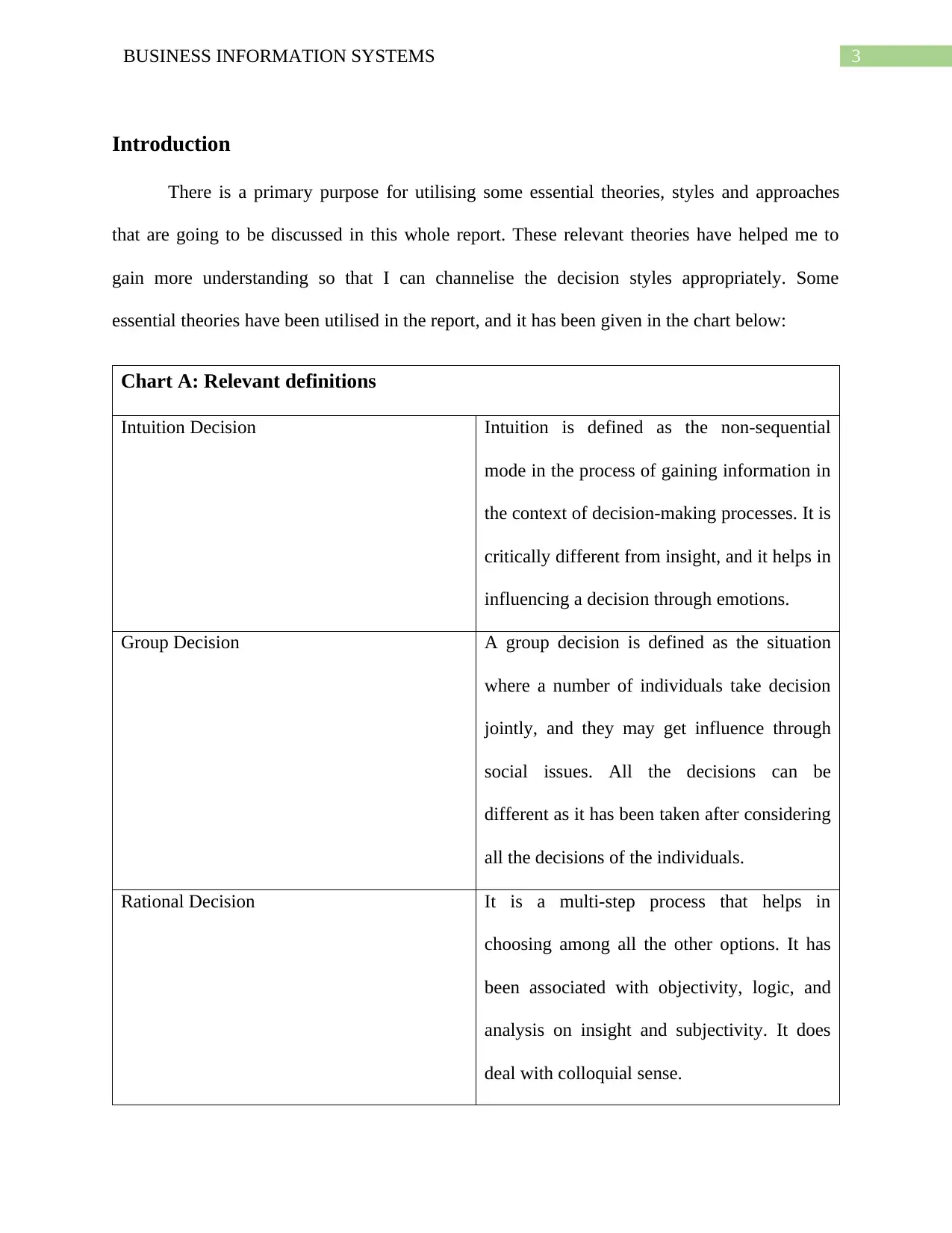
3BUSINESS INFORMATION SYSTEMS
Introduction
There is a primary purpose for utilising some essential theories, styles and approaches
that are going to be discussed in this whole report. These relevant theories have helped me to
gain more understanding so that I can channelise the decision styles appropriately. Some
essential theories have been utilised in the report, and it has been given in the chart below:
Chart A: Relevant definitions
Intuition Decision Intuition is defined as the non-sequential
mode in the process of gaining information in
the context of decision-making processes. It is
critically different from insight, and it helps in
influencing a decision through emotions.
Group Decision A group decision is defined as the situation
where a number of individuals take decision
jointly, and they may get influence through
social issues. All the decisions can be
different as it has been taken after considering
all the decisions of the individuals.
Rational Decision It is a multi-step process that helps in
choosing among all the other options. It has
been associated with objectivity, logic, and
analysis on insight and subjectivity. It does
deal with colloquial sense.
Introduction
There is a primary purpose for utilising some essential theories, styles and approaches
that are going to be discussed in this whole report. These relevant theories have helped me to
gain more understanding so that I can channelise the decision styles appropriately. Some
essential theories have been utilised in the report, and it has been given in the chart below:
Chart A: Relevant definitions
Intuition Decision Intuition is defined as the non-sequential
mode in the process of gaining information in
the context of decision-making processes. It is
critically different from insight, and it helps in
influencing a decision through emotions.
Group Decision A group decision is defined as the situation
where a number of individuals take decision
jointly, and they may get influence through
social issues. All the decisions can be
different as it has been taken after considering
all the decisions of the individuals.
Rational Decision It is a multi-step process that helps in
choosing among all the other options. It has
been associated with objectivity, logic, and
analysis on insight and subjectivity. It does
deal with colloquial sense.
Paraphrase This Document
Need a fresh take? Get an instant paraphrase of this document with our AI Paraphraser
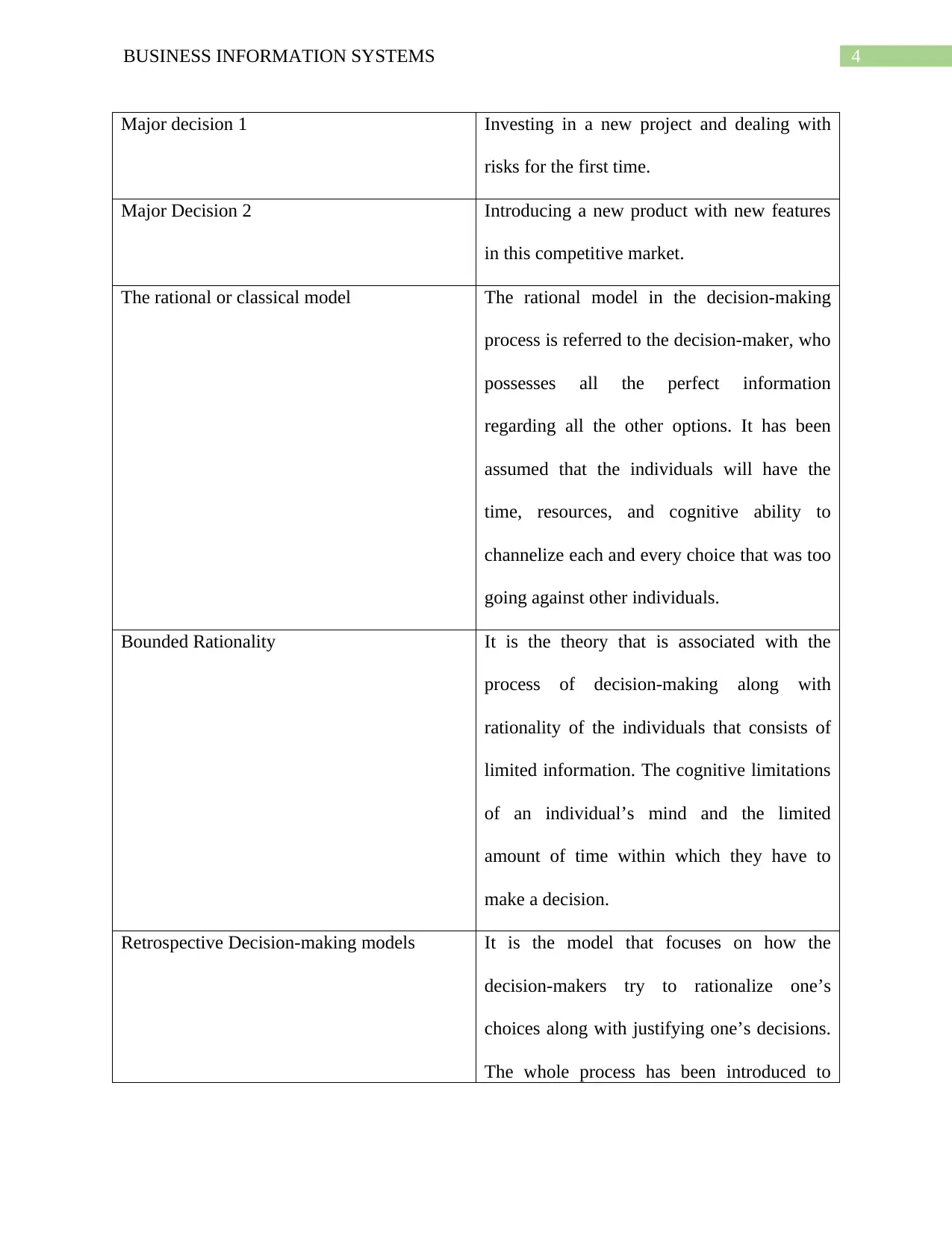
4BUSINESS INFORMATION SYSTEMS
Major decision 1 Investing in a new project and dealing with
risks for the first time.
Major Decision 2 Introducing a new product with new features
in this competitive market.
The rational or classical model The rational model in the decision-making
process is referred to the decision-maker, who
possesses all the perfect information
regarding all the other options. It has been
assumed that the individuals will have the
time, resources, and cognitive ability to
channelize each and every choice that was too
going against other individuals.
Bounded Rationality It is the theory that is associated with the
process of decision-making along with
rationality of the individuals that consists of
limited information. The cognitive limitations
of an individual’s mind and the limited
amount of time within which they have to
make a decision.
Retrospective Decision-making models It is the model that focuses on how the
decision-makers try to rationalize one’s
choices along with justifying one’s decisions.
The whole process has been introduced to
Major decision 1 Investing in a new project and dealing with
risks for the first time.
Major Decision 2 Introducing a new product with new features
in this competitive market.
The rational or classical model The rational model in the decision-making
process is referred to the decision-maker, who
possesses all the perfect information
regarding all the other options. It has been
assumed that the individuals will have the
time, resources, and cognitive ability to
channelize each and every choice that was too
going against other individuals.
Bounded Rationality It is the theory that is associated with the
process of decision-making along with
rationality of the individuals that consists of
limited information. The cognitive limitations
of an individual’s mind and the limited
amount of time within which they have to
make a decision.
Retrospective Decision-making models It is the model that focuses on how the
decision-makers try to rationalize one’s
choices along with justifying one’s decisions.
The whole process has been introduced to

5BUSINESS INFORMATION SYSTEMS
justify through scientific rigour.
justify through scientific rigour.
⊘ This is a preview!⊘
Do you want full access?
Subscribe today to unlock all pages.

Trusted by 1+ million students worldwide
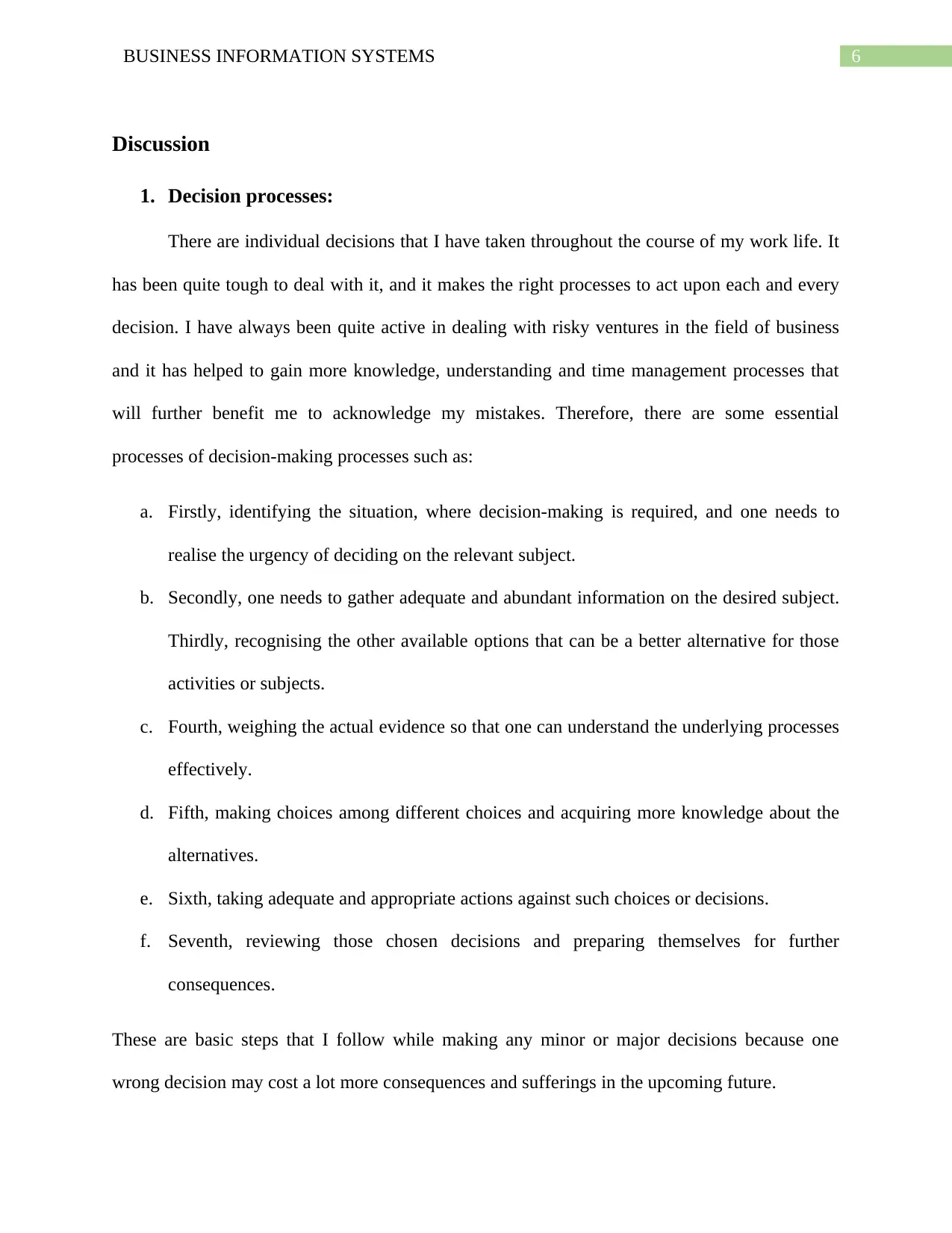
6BUSINESS INFORMATION SYSTEMS
Discussion
1. Decision processes:
There are individual decisions that I have taken throughout the course of my work life. It
has been quite tough to deal with it, and it makes the right processes to act upon each and every
decision. I have always been quite active in dealing with risky ventures in the field of business
and it has helped to gain more knowledge, understanding and time management processes that
will further benefit me to acknowledge my mistakes. Therefore, there are some essential
processes of decision-making processes such as:
a. Firstly, identifying the situation, where decision-making is required, and one needs to
realise the urgency of deciding on the relevant subject.
b. Secondly, one needs to gather adequate and abundant information on the desired subject.
Thirdly, recognising the other available options that can be a better alternative for those
activities or subjects.
c. Fourth, weighing the actual evidence so that one can understand the underlying processes
effectively.
d. Fifth, making choices among different choices and acquiring more knowledge about the
alternatives.
e. Sixth, taking adequate and appropriate actions against such choices or decisions.
f. Seventh, reviewing those chosen decisions and preparing themselves for further
consequences.
These are basic steps that I follow while making any minor or major decisions because one
wrong decision may cost a lot more consequences and sufferings in the upcoming future.
Discussion
1. Decision processes:
There are individual decisions that I have taken throughout the course of my work life. It
has been quite tough to deal with it, and it makes the right processes to act upon each and every
decision. I have always been quite active in dealing with risky ventures in the field of business
and it has helped to gain more knowledge, understanding and time management processes that
will further benefit me to acknowledge my mistakes. Therefore, there are some essential
processes of decision-making processes such as:
a. Firstly, identifying the situation, where decision-making is required, and one needs to
realise the urgency of deciding on the relevant subject.
b. Secondly, one needs to gather adequate and abundant information on the desired subject.
Thirdly, recognising the other available options that can be a better alternative for those
activities or subjects.
c. Fourth, weighing the actual evidence so that one can understand the underlying processes
effectively.
d. Fifth, making choices among different choices and acquiring more knowledge about the
alternatives.
e. Sixth, taking adequate and appropriate actions against such choices or decisions.
f. Seventh, reviewing those chosen decisions and preparing themselves for further
consequences.
These are basic steps that I follow while making any minor or major decisions because one
wrong decision may cost a lot more consequences and sufferings in the upcoming future.
Paraphrase This Document
Need a fresh take? Get an instant paraphrase of this document with our AI Paraphraser
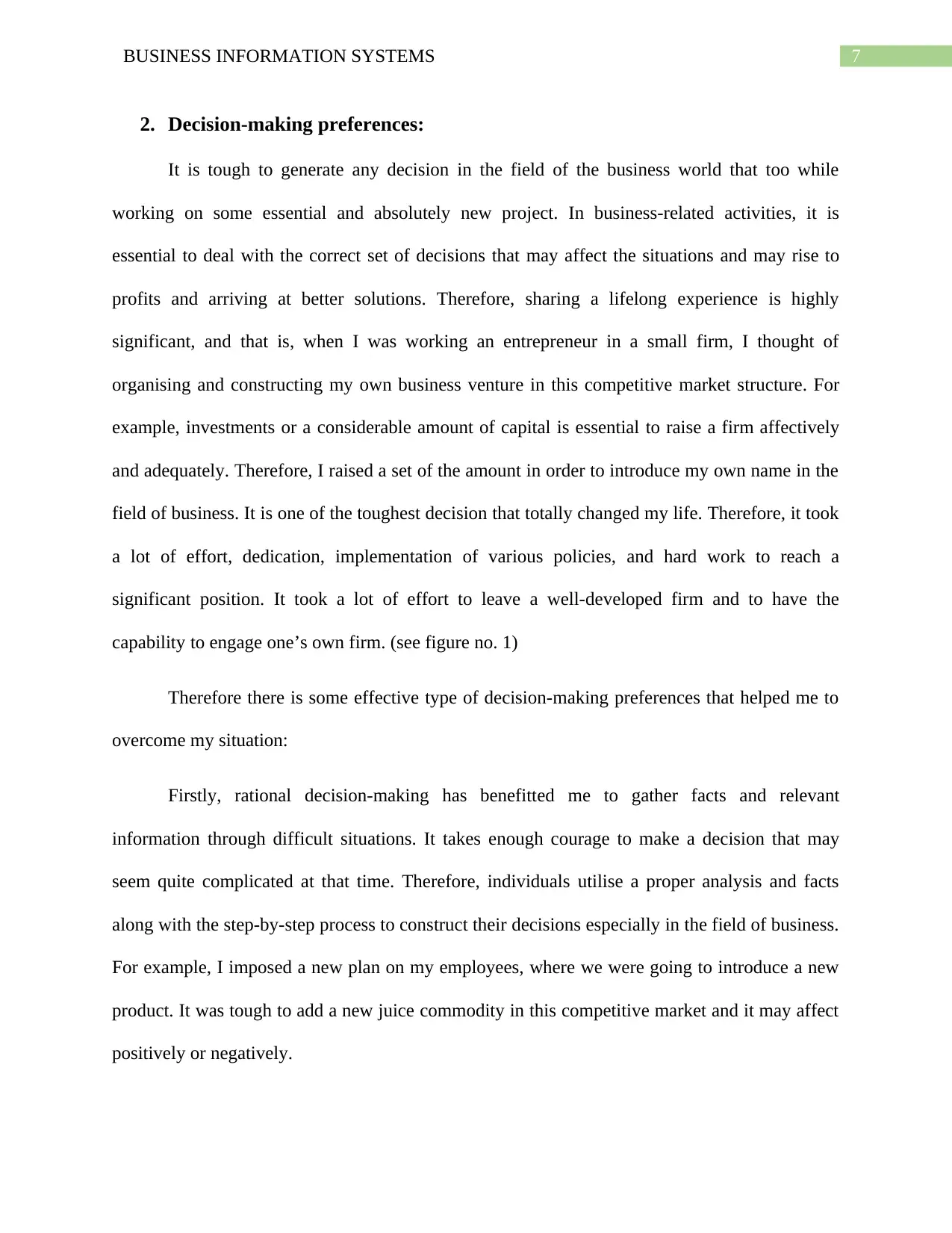
7BUSINESS INFORMATION SYSTEMS
2. Decision-making preferences:
It is tough to generate any decision in the field of the business world that too while
working on some essential and absolutely new project. In business-related activities, it is
essential to deal with the correct set of decisions that may affect the situations and may rise to
profits and arriving at better solutions. Therefore, sharing a lifelong experience is highly
significant, and that is, when I was working an entrepreneur in a small firm, I thought of
organising and constructing my own business venture in this competitive market structure. For
example, investments or a considerable amount of capital is essential to raise a firm affectively
and adequately. Therefore, I raised a set of the amount in order to introduce my own name in the
field of business. It is one of the toughest decision that totally changed my life. Therefore, it took
a lot of effort, dedication, implementation of various policies, and hard work to reach a
significant position. It took a lot of effort to leave a well-developed firm and to have the
capability to engage one’s own firm. (see figure no. 1)
Therefore there is some effective type of decision-making preferences that helped me to
overcome my situation:
Firstly, rational decision-making has benefitted me to gather facts and relevant
information through difficult situations. It takes enough courage to make a decision that may
seem quite complicated at that time. Therefore, individuals utilise a proper analysis and facts
along with the step-by-step process to construct their decisions especially in the field of business.
For example, I imposed a new plan on my employees, where we were going to introduce a new
product. It was tough to add a new juice commodity in this competitive market and it may affect
positively or negatively.
2. Decision-making preferences:
It is tough to generate any decision in the field of the business world that too while
working on some essential and absolutely new project. In business-related activities, it is
essential to deal with the correct set of decisions that may affect the situations and may rise to
profits and arriving at better solutions. Therefore, sharing a lifelong experience is highly
significant, and that is, when I was working an entrepreneur in a small firm, I thought of
organising and constructing my own business venture in this competitive market structure. For
example, investments or a considerable amount of capital is essential to raise a firm affectively
and adequately. Therefore, I raised a set of the amount in order to introduce my own name in the
field of business. It is one of the toughest decision that totally changed my life. Therefore, it took
a lot of effort, dedication, implementation of various policies, and hard work to reach a
significant position. It took a lot of effort to leave a well-developed firm and to have the
capability to engage one’s own firm. (see figure no. 1)
Therefore there is some effective type of decision-making preferences that helped me to
overcome my situation:
Firstly, rational decision-making has benefitted me to gather facts and relevant
information through difficult situations. It takes enough courage to make a decision that may
seem quite complicated at that time. Therefore, individuals utilise a proper analysis and facts
along with the step-by-step process to construct their decisions especially in the field of business.
For example, I imposed a new plan on my employees, where we were going to introduce a new
product. It was tough to add a new juice commodity in this competitive market and it may affect
positively or negatively.
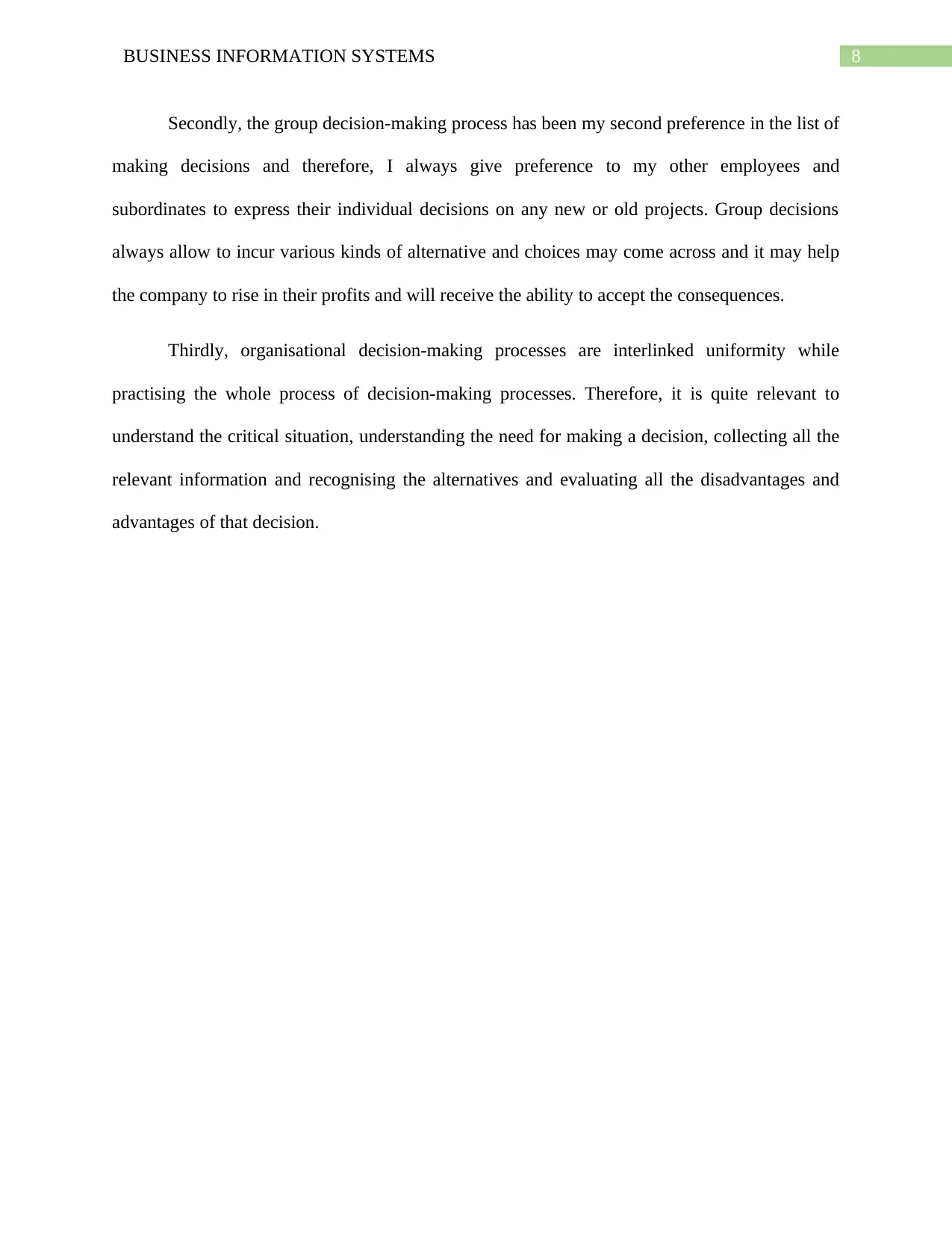
8BUSINESS INFORMATION SYSTEMS
Secondly, the group decision-making process has been my second preference in the list of
making decisions and therefore, I always give preference to my other employees and
subordinates to express their individual decisions on any new or old projects. Group decisions
always allow to incur various kinds of alternative and choices may come across and it may help
the company to rise in their profits and will receive the ability to accept the consequences.
Thirdly, organisational decision-making processes are interlinked uniformity while
practising the whole process of decision-making processes. Therefore, it is quite relevant to
understand the critical situation, understanding the need for making a decision, collecting all the
relevant information and recognising the alternatives and evaluating all the disadvantages and
advantages of that decision.
Secondly, the group decision-making process has been my second preference in the list of
making decisions and therefore, I always give preference to my other employees and
subordinates to express their individual decisions on any new or old projects. Group decisions
always allow to incur various kinds of alternative and choices may come across and it may help
the company to rise in their profits and will receive the ability to accept the consequences.
Thirdly, organisational decision-making processes are interlinked uniformity while
practising the whole process of decision-making processes. Therefore, it is quite relevant to
understand the critical situation, understanding the need for making a decision, collecting all the
relevant information and recognising the alternatives and evaluating all the disadvantages and
advantages of that decision.
⊘ This is a preview!⊘
Do you want full access?
Subscribe today to unlock all pages.

Trusted by 1+ million students worldwide
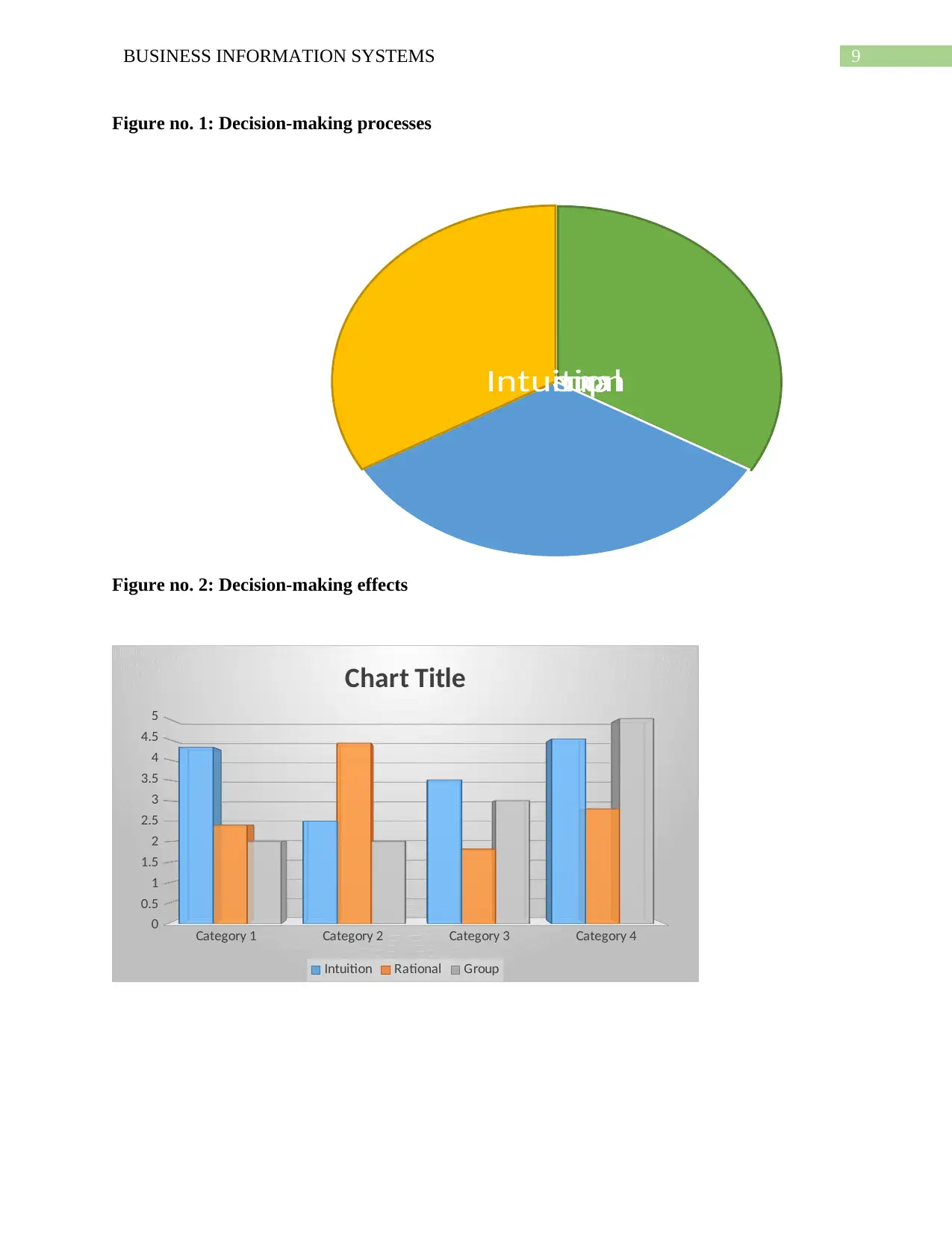
9BUSINESS INFORMATION SYSTEMS
Figure no. 1: Decision-making processes
Figure no. 2: Decision-making effects
Category 1 Category 2 Category 3 Category 4
0
0.5
1
1.5
2
2.5
3
3.5
4
4.5
5
Chart Title
Intuition Rational Group
GroupRationalIntuition
Figure no. 1: Decision-making processes
Figure no. 2: Decision-making effects
Category 1 Category 2 Category 3 Category 4
0
0.5
1
1.5
2
2.5
3
3.5
4
4.5
5
Chart Title
Intuition Rational Group
GroupRationalIntuition
Paraphrase This Document
Need a fresh take? Get an instant paraphrase of this document with our AI Paraphraser
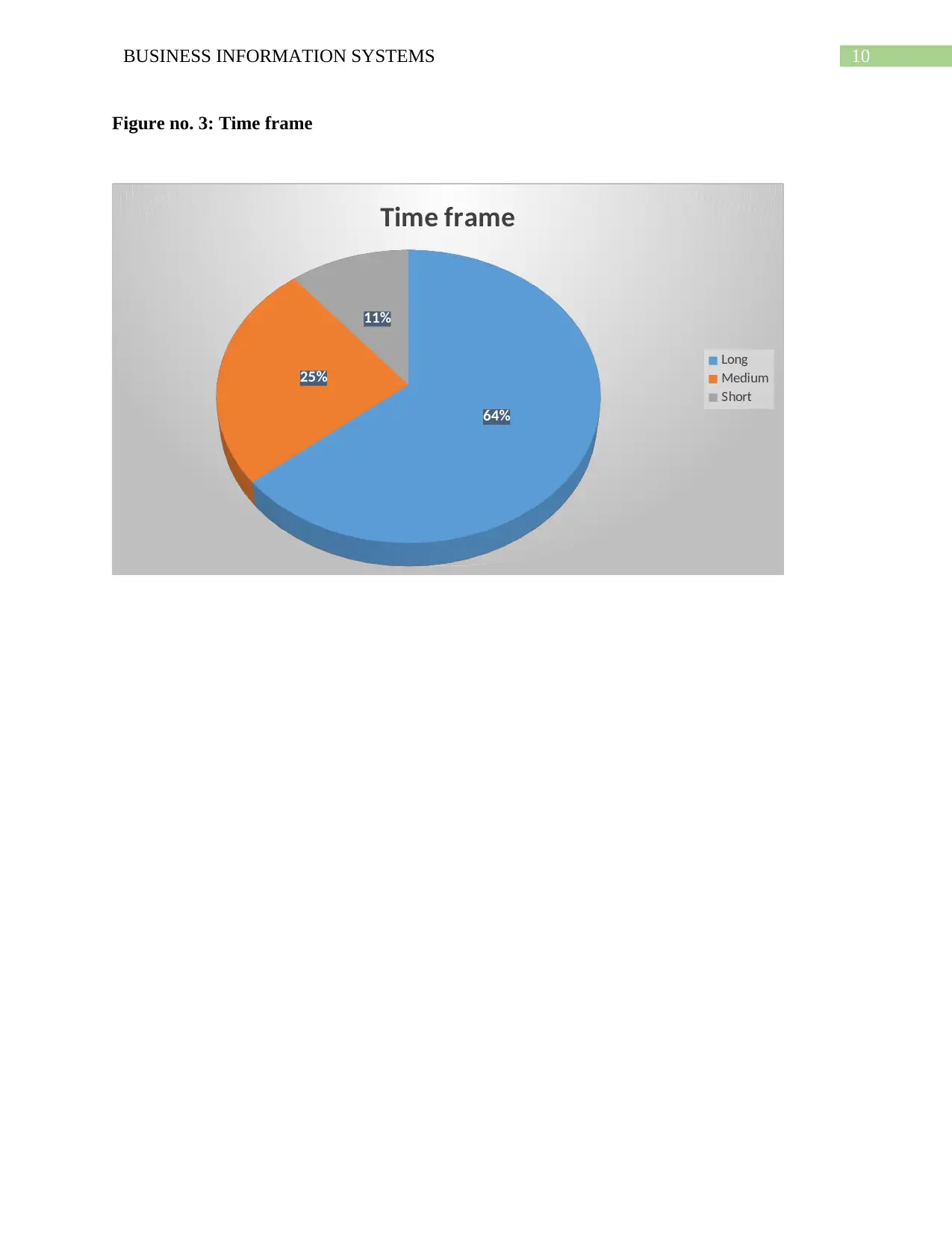
10BUSINESS INFORMATION SYSTEMS
Figure no. 3: Time frame
64%
25%
11%
Time frame
Long
Medium
Short
Figure no. 3: Time frame
64%
25%
11%
Time frame
Long
Medium
Short
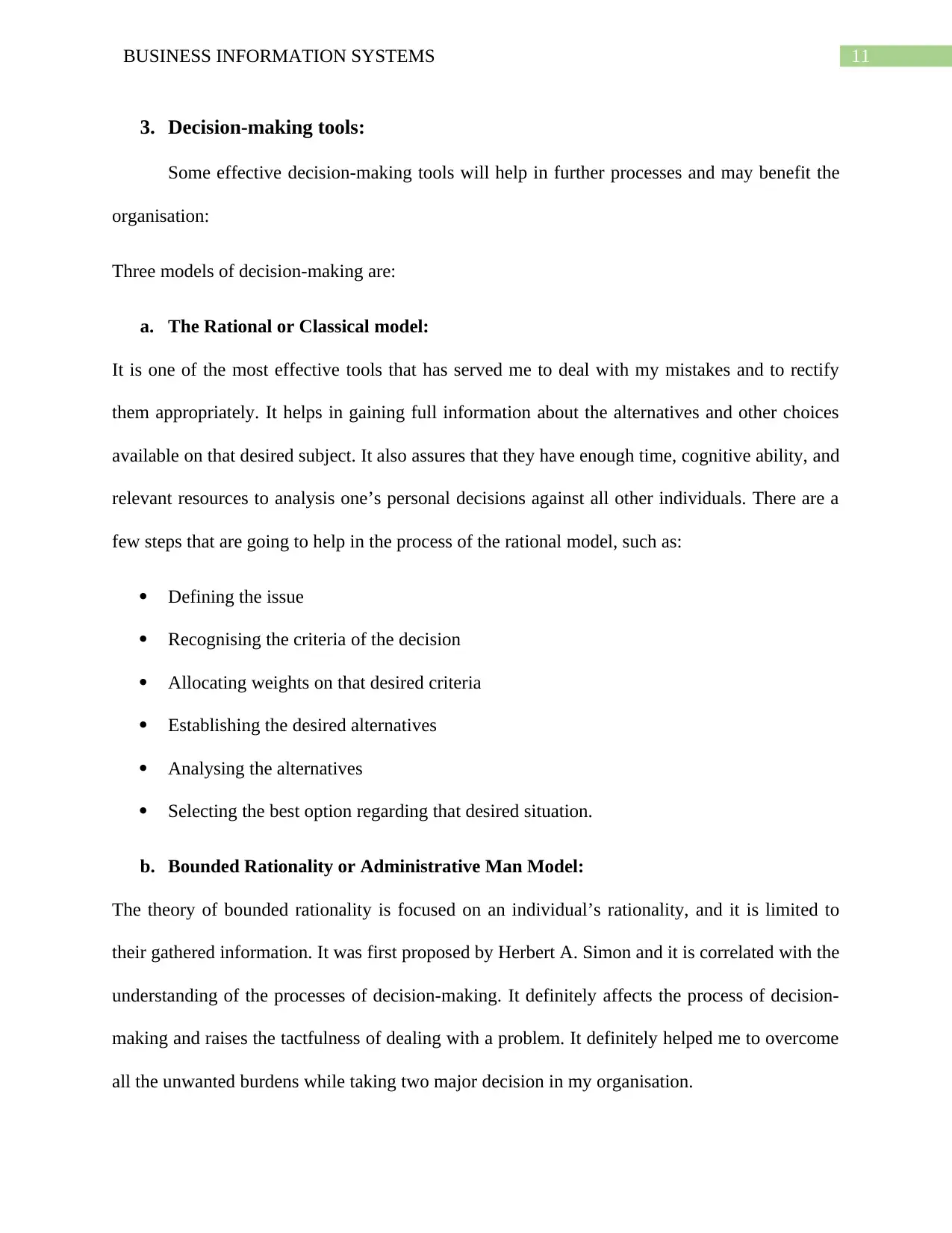
11BUSINESS INFORMATION SYSTEMS
3. Decision-making tools:
Some effective decision-making tools will help in further processes and may benefit the
organisation:
Three models of decision-making are:
a. The Rational or Classical model:
It is one of the most effective tools that has served me to deal with my mistakes and to rectify
them appropriately. It helps in gaining full information about the alternatives and other choices
available on that desired subject. It also assures that they have enough time, cognitive ability, and
relevant resources to analysis one’s personal decisions against all other individuals. There are a
few steps that are going to help in the process of the rational model, such as:
Defining the issue
Recognising the criteria of the decision
Allocating weights on that desired criteria
Establishing the desired alternatives
Analysing the alternatives
Selecting the best option regarding that desired situation.
b. Bounded Rationality or Administrative Man Model:
The theory of bounded rationality is focused on an individual’s rationality, and it is limited to
their gathered information. It was first proposed by Herbert A. Simon and it is correlated with the
understanding of the processes of decision-making. It definitely affects the process of decision-
making and raises the tactfulness of dealing with a problem. It definitely helped me to overcome
all the unwanted burdens while taking two major decision in my organisation.
3. Decision-making tools:
Some effective decision-making tools will help in further processes and may benefit the
organisation:
Three models of decision-making are:
a. The Rational or Classical model:
It is one of the most effective tools that has served me to deal with my mistakes and to rectify
them appropriately. It helps in gaining full information about the alternatives and other choices
available on that desired subject. It also assures that they have enough time, cognitive ability, and
relevant resources to analysis one’s personal decisions against all other individuals. There are a
few steps that are going to help in the process of the rational model, such as:
Defining the issue
Recognising the criteria of the decision
Allocating weights on that desired criteria
Establishing the desired alternatives
Analysing the alternatives
Selecting the best option regarding that desired situation.
b. Bounded Rationality or Administrative Man Model:
The theory of bounded rationality is focused on an individual’s rationality, and it is limited to
their gathered information. It was first proposed by Herbert A. Simon and it is correlated with the
understanding of the processes of decision-making. It definitely affects the process of decision-
making and raises the tactfulness of dealing with a problem. It definitely helped me to overcome
all the unwanted burdens while taking two major decision in my organisation.
⊘ This is a preview!⊘
Do you want full access?
Subscribe today to unlock all pages.

Trusted by 1+ million students worldwide
1 out of 19
Related Documents
Your All-in-One AI-Powered Toolkit for Academic Success.
+13062052269
info@desklib.com
Available 24*7 on WhatsApp / Email
![[object Object]](/_next/static/media/star-bottom.7253800d.svg)
Unlock your academic potential
Copyright © 2020–2025 A2Z Services. All Rights Reserved. Developed and managed by ZUCOL.





